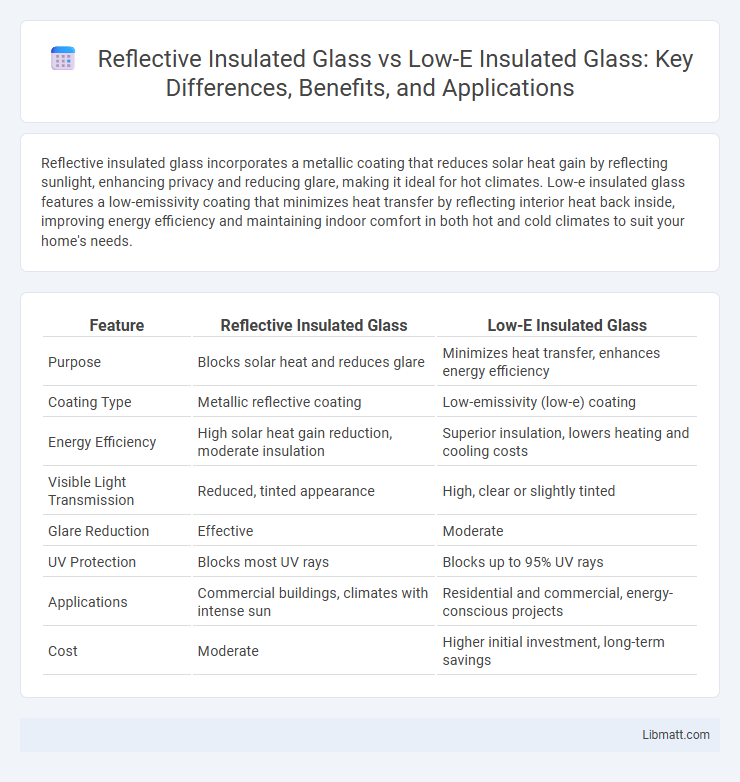Reflective insulated glass incorporates a metallic coating that reduces solar heat gain by reflecting sunlight, enhancing privacy and reducing glare, making it ideal for hot climates. Low-e insulated glass features a low-emissivity coating that minimizes heat transfer by reflecting interior heat back inside, improving energy efficiency and maintaining indoor comfort in both hot and cold climates to suit your home's needs.
Table of Comparison
| Feature | Reflective Insulated Glass | Low-E Insulated Glass |
|---|---|---|
| Purpose | Blocks solar heat and reduces glare | Minimizes heat transfer, enhances energy efficiency |
| Coating Type | Metallic reflective coating | Low-emissivity (low-e) coating |
| Energy Efficiency | High solar heat gain reduction, moderate insulation | Superior insulation, lowers heating and cooling costs |
| Visible Light Transmission | Reduced, tinted appearance | High, clear or slightly tinted |
| Glare Reduction | Effective | Moderate |
| UV Protection | Blocks most UV rays | Blocks up to 95% UV rays |
| Applications | Commercial buildings, climates with intense sun | Residential and commercial, energy-conscious projects |
| Cost | Moderate | Higher initial investment, long-term savings |
Introduction to Reflective and Low-E Insulated Glass
Reflective insulated glass features a metallic coating that reduces solar heat gain by reflecting sunlight, making it ideal for energy-efficient buildings in hot climates. Low-E insulated glass incorporates a microscopically thin, transparent coating that minimizes infrared and ultraviolet light while maximizing natural daylight, enhancing insulation without compromising visibility. Both types improve thermal performance in windows but serve distinct purposes based on climate and energy-saving priorities.
Understanding Insulated Glass Technology
Reflective insulated glass uses a metallic coated layer to reduce solar heat gain by reflecting sunlight, making it ideal for energy-efficient buildings in hot climates. Low-e insulated glass features a microscopically thin coating that minimizes infrared and ultraviolet light without compromising visible light, enhancing thermal insulation and reducing energy costs. Understanding these technologies helps you select the best insulated glass for superior temperature control and comfort in your space.
What is Reflective Insulated Glass?
Reflective insulated glass features a metallic coating designed to reflect solar heat and reduce glare, improving energy efficiency in buildings. This glass type minimizes solar heat gain by reflecting infrared rays while maintaining natural visible light transmission. You can enhance your space's thermal comfort and privacy with reflective insulated glass, especially in hot climates.
What is Low-E Insulated Glass?
Low-E insulated glass features a microscopically thin, transparent coating that reflects infrared energy, improving thermal insulation and reducing heat transfer. This technology helps maintain your indoor temperature by blocking heat from entering in summer and retaining warmth in winter, enhancing energy efficiency. Compared to reflective insulated glass, Low-E glass offers better natural light transmission while still providing effective solar control.
Thermal Performance Comparison
Reflective insulated glass uses a metallic coating to reflect solar radiation, significantly reducing heat gain and improving energy efficiency in warm climates. Low-e insulated glass features a microscopically thin, transparent coating that minimizes infrared heat transfer while allowing visible light to pass through, enhancing thermal performance by retaining indoor heat during colder months. Both types improve insulation values, but low-e glass typically offers superior year-round thermal regulation by balancing heat retention and solar control.
Energy Efficiency Differences
Reflective insulated glass uses a metallic coating to reflect solar radiation and reduce heat gain, making it highly effective in hot climates by lowering cooling costs. Low-e insulated glass features a microscopically thin, transparent coating that minimizes infrared and ultraviolet light transfer while allowing visible light, enhancing both heating and cooling energy efficiency. In comparison, low-e glass offers superior year-round energy performance by balancing solar heat control and thermal insulation, whereas reflective glass primarily excels in solar heat rejection.
Solar Control and UV Protection
Reflective insulated glass features a metallic coating that effectively reduces solar heat gain by reflecting a significant portion of infrared radiation, making it ideal for controlling solar heat in hot climates. Low-e insulated glass utilizes a microscopically thin, transparent coating that minimizes ultraviolet (UV) rays and infrared light transmission while maintaining visible light clarity, enhancing energy efficiency and protecting interiors from UV damage. Your choice between these two depends on prioritizing solar heat reflection with a mirrored appearance or maximizing natural light with subtle UV protection.
Aesthetic and Visibility Considerations
Reflective insulated glass features a mirrored surface that significantly reduces glare and solar heat gain but can alter the natural appearance of the exterior and limit clear visibility through the window. Low-e insulated glass uses a thin, transparent coating that minimizes ultraviolet and infrared light transmission while maintaining high optical clarity, preserving natural color views and daylight. Choosing between the two depends on balancing energy efficiency with desired aesthetic appeal and unobstructed visibility.
Cost and Long-Term Value
Reflective insulated glass typically has a higher upfront cost due to its specialized coatings that reduce solar heat gain and glare, making it ideal for buildings in hot climates. Low-e insulated glass offers a more balanced cost with coatings designed to improve thermal efficiency by minimizing heat transfer, which can result in significant energy savings over time. Long-term value favors low-e glass for most applications due to its effectiveness in reducing heating and cooling expenses, while reflective glass provides superior performance in specific environments where controlling sunlight intensity is critical.
Choosing the Right Glass for Your Project
Reflective insulated glass uses a metallic coating to reduce solar heat gain and glare, making it ideal for projects in hot climates requiring enhanced privacy and energy efficiency. Low-e insulated glass features a microscopically thin, transparent coating that blocks ultraviolet and infrared light while allowing visible light to pass, optimizing thermal performance for both heating and cooling seasons. Selecting the right glass depends on your project's climate, energy goals, aesthetic preferences, and budget to maximize comfort and reduce energy costs effectively.
Reflective insulated glass vs low-e insulated glass Infographic

 libmatt.com
libmatt.com